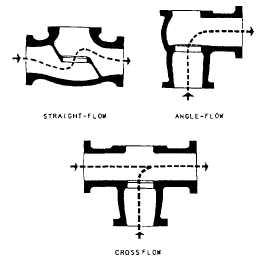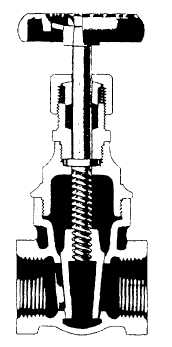Figure 9-18.—Types of globe valve bodies.
requirements of flow. Figure 9-18 shows the
common types of globe valve bodies: straight-
flow, angle-flow, and cross flow. Globe valves
are used extensively throughout the engineering
plant and other parts of the ship in a variety of
systems.
GATE VALVES.— Gate valves are used when
a straight-line flow of fluid and minimum restric-
tion is desired. Gate valves are so named because
the part that either stops or allows flow through
the valve acts somewhat like the opening or
closing of a gate and is called, appropriately, the
gate. The gate is usually wedge shaped. When the
valve is wide open, the gate is fully drawn up
into the valve, leaving an opening for flow
through the valve the same size as the pipe in
which the valve is installed. Therefore, there is
little pressure drop or flow restriction through the
valve. Gate valves are not suitable for throttling
purposes since the control of flow would be
difficult due to valve design and since the flow
of fluid slapping against a partially open gate can
cause extensive damage to the valve. Except as
specifically authorized, gate valves should not be
used for throttling.
Gate valves are classified as either RISING-
STEM or NONRISING-STEM valves. On the
nonrising-stem gate valve shown in figure 9-19,
the stem is threaded on the lower end into the gate.
As the handwheel on the stem is rotated, the gate
travels up or down the stem on the threads, while
the stem remains vertically stationary. This type
of valve almost always has a pointer-type indicator
Figure 9-19.—Cutaway view of a gate valve (nonrising-stem
type).
threaded onto the upper end of the stem to
indicate valve position.
The rising-stem gate valve, shown in figure
9-20, has the stem attached to the gate; the gate
and stem rise and lower together as the valve is
operated.
Gate valves used in steam systems have flexible
gates. The reason for using a flexible gate is to
prevent binding of the gate within the valve when
the valve is in the closed position. When steam
lines are heated, they will expand, causing some
distortion of valve bodies. If a solid gate fits
snugly between the seat of a valve in a cold steam
system, when the system is heated and pipes
elongate, the seats will compress against the gate,
wedging the gate between them and clamping the
valve shut. This problem is overcome by use of
a flexible gate (two circular plates attached to each
other with a flexible hub in the middle). This
design allows the gate to flex as the valve seat
compresses it, thereby preventing clamping.
BUTTERFLY VALVES.— The butterfly
valve, one type of which is shown in figure 9-21,
may be used in a variety of systems aboard ship.
These valves can be used effectively in freshwater,
saltwater, JP-5, F-76 (naval distillate), lube oil,
and chill water systems aboard ship. The butterfly
valve is light in weight, relatively small, relatively
9-14




